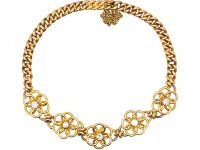-
Your Shopping Bag is empty

Want to see it in person?
We look forward to welcoming you to the AJC Townhouse, our home in the heart of London's Mayfair - and one of London's best kept secrets.
Book Your Appointment

 Free Worldwide Delivery
Free Worldwide DeliveryAn unusual 15ct62.5% pure gold (or 625 parts pure gold and 375 parts other metals). Popular during the Victorian, Edwardian and Art Deco eras but was discontinued in the mid-1930s. gold bracelet that was made circa 1910. It is composed of five stylised flowers with a diamondA precious, lustrous gemstone made of highly compressed carbon. Diamonds are one of the hardest materials known to mankind. Colours of diamonds range from colourless, yellow, orange and brown to almost black. Natural coloured (or ‘fancy’) diamonds can be extremely rare. The cut, colour, clarity and carat weight of a diamond are the criteria jewellers use... in the centre of each one. They lead on to curb links that join a hidden tongue clasp with an added safety chainA small chain applied to a piece of jewellery with the purpose of adding additional security to prevent loss. On bracelets and necklaces a safety chain will often join the clasp ends should the clasp fail. On a brooch it is often attached to a small pin which is to be used in tandem with the main brooch pin. for extra security.
Perfect for day and night wear.

We all love this unusual bracelet!
We are pleased to offer FREE SHIPPING on all purchases.
All orders are fully insured and dispatched securely by our trusted partner, DHL Express.
We offer a 30 day, full money-back guarantee on all purchases.
UK - Free, with a pre-paid returns envelope
USA, Europe & Rest of World - Buyer pays for return postage and any taxes/duties applied


We look forward to welcoming you to the AJC Townhouse, our home in the heart of London's Mayfair - and one of London's best kept secrets.
Book Your Appointment
Buying antique jewellery is both ethical and eco-friendly as harmful and destructive mining processes are not needed to make an item yours. So give yourself a pat on the back!
Find Out More


We always stand by our five core principles:
Quality, Rarity, Expertise, Peace of Mind and Personal Touch